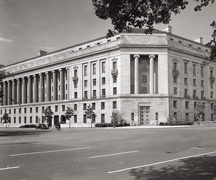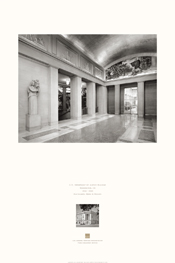Location: 950 Pennsylvania Avenue NW, Washington, DC 20530
History
In 1935, when the U.S. Department of Justice building was completed, a 150-year-old government entity was finally provided with its first permanent home. The Office of the Attorney General was established by the first U.S. Congress in 1789 to “advise the President and occasionally other officials about legal matters.” By the second half of the nineteenth century, the Office of the Attorney General had expanded to the size and complexity of an executive department of the U.S. government. In recognition of this fact, the U.S. Congress created the U.S. Department of Justice, headed by the Attorney General, in 1870.
Prior to the construction of the U.S. Department of Justice building, the Office of the Attorney General and the U.S. Department of Justice had occupied a succession of temporary spaces in federal government buildings and privately owned office buildings. While plans to provide the Department with its own building were developed as early as 1910, it was not until the late 1920s that significant progress was made toward this goal.
The 1926 Public Buildings Act, which permitted the government to hire private architects for the design of federal buildings, heralded the beginning of the country’s largest public buildings construction program. Among the most significant early projects generated under the new legislation was the development of a 70-acre site (now known as the Federal Triangle) between the Capitol and the White House in Washington, DC. U.S. Secretary of the Treasury Andrew W. Mellon and a distinguished Board of Architectural Consultants, headed by Edward H. Bennett of the Chicago architectural firm of Bennett, Parsons, and Frost, developed design guidelines for the site.
Under Bennett’s direction, each member of the Board of Architectural Consultants designed one of the buildings in the Federal Triangle complex. The goal of the project was to provide each government agency or bureau with a building that would address its functional needs, while combining the individual buildings into a harmonious, monumental overall design expressive of the dignity and authority of the federal government. The U.S. Department of Justice building is a key component of the design.
Architecture
Milton B. Medary, of the noted Philadelphia architectural firm Zantzinger, Borie and Medary, was selected as the architect for the U.S. Department of Justice building. Upon Medary’s death in 1929, his two partners, Clarence C. Zantzinger and Charles L. Borie, Jr., took over the project.
In the U.S. Department of Justice building, Zantzinger and Borie skillfully blended Classical influences with Art Deco and Greek features to create a design that foreshadowed the advent of Modern architecture. The design is compatible with other Federal Triangle buildings; its limestone facade, red-tile hipped roof, and classically inspired colonnades are common features of federal buildings in the area. Like most Federal Triangle buildings, it was designed with interior courtyards to provide natural light and ventilation. Located on a prominent trapezoidal lot bounded by Constitution and Pennsylvania Avenues and Ninth and Tenth Streets, Northwest, it contains over one million square feet of space.
While the overall building design conforms with a consistent design vocabulary established in the Federal Triangle, it is distinguished by Art Deco architectural elements and its innovative use of aluminum for details that were traditionally cast in bronze. All entrances to the building feature 20-foot-high aluminum doors that slide into recessed pockets. Interior stair railings, grilles, and door trim are aluminum, as are Art Deco torcheres, doors for the building’s 25 elevators, and more than 10,000 light fixtures.
The building has many distinctive interior spaces, including the handsome Great Hall and the Law Library. The two-story Great Hall features Art Deco light fixtures and a terra-cotta tile floor with gray marble borders. The Law Library, located on the fifth floor, is a two-story room distinguished by a pair of tall Art Deco lights and a 20-panel mural by Maurice Sterne.
Sculpture is skillfully integrated into the fabric of the building. Sculptor C. Paul Jennewein was selected to create a unified design concept for the building’s exterior and interior spaces, designing 57 sculptural elements for the building. His work ranged from the carved limestone figures for the pediments on the Constitution Avenue facade, to the aluminum Art Deco torcheres and light fixtures throughout the interior.
The interior of the U.S. Department of Justice building contains many decorative wall paintings. The building’s extensive murals depict scenes of daily life from throughout American history and symbolic interpretations or allegorical themes relating to the role of justice in our society. In all, 68 murals were completed between 1935 and 1941, at a cost of $68,000—one percent of the cost of the building.
The striking, colorful concrete mosaics that enrich the ceilings of the vehicular and pedestrian entryways from Ninth and Tenth Streets were created by the Washington, DC., master craftsman John Joseph Earley, an innovator in the aesthetic applications of the material. Visible from the street, these mosaics retain much of the brilliance of their original colors.
The U.S. Department of Justice building retains exceptional historic integrity. The original facades, lobbies, corridors, library, Great Hall, executive suites and private offices retain their original materials and design, including the extensive use of ornamental aluminum. In 1999, major renovation work was begun to update systems original to the building, including plumbing, electrical, heating and cooling, and elevators. This project includes replication of original lighting for the building’s corridors and other ornamental spaces.
Significant Events
- 1789: The first U.S. Congress creates the Office of the Attorney General.
- 1792: The position of Attorney General is recognized as a Cabinet-level post.
- 1870: President Ulysses S. Grant signs a bill creating the Department of Justice.
- 1908 and 1928: The U.S. Congress authorizes the purchase of land in the area now known as the Federal Triangle for departmental offices.
- 1930: The U.S. Congress appropriates $10,000,000 for the construction of a permanent headquarters for the Department of Justice in the Federal Triangle.
- 1931-1934: Construction of the U.S. Department of Justice building.
- 1935-1941: 68 murals are painted in the building.
- 1966: The Department of Justice is listed in the National Register of Historic Places as part of the Pennsylvania Avenue National Historic Site.
- 2001: Building is renamed in honor of Robert F. Kennedy, U.S. Attorney General from 1961-1964.
Facts
- Architect: Zantzinger, Borie and Medary of Philadelphia, Pennsylvania
- Architectural Style: Classical Revival, with Art Deco ornamentation
- Construction Dates: 1931-1935
- GSA Building Number:
- Landmark Status: National Register Listed, Part of the Pennsylvania Avenue National Historic Site
- Primary Materials: Indiana limestone facade over a steel frame; aluminum details
- Prominent Feature: Sculpture, designed by C. Paul Jennewein and integrated into the building’s exterior and interior; 68 murals by prominent artists.
Poster Download
Download the poster [PDF - 356 KB]

 U.S. General Services Administration
U.S. General Services Administration

